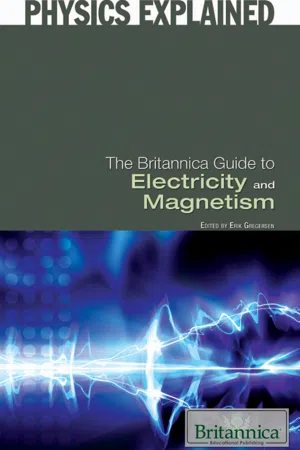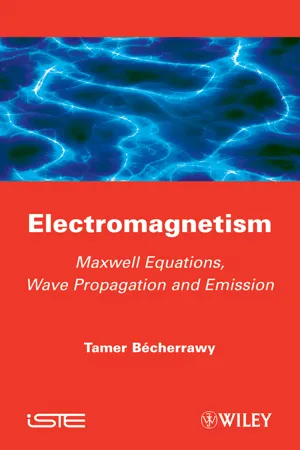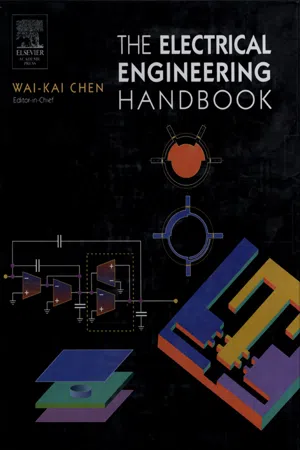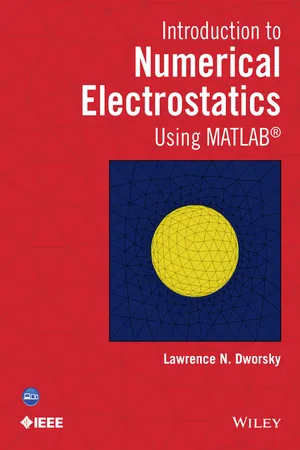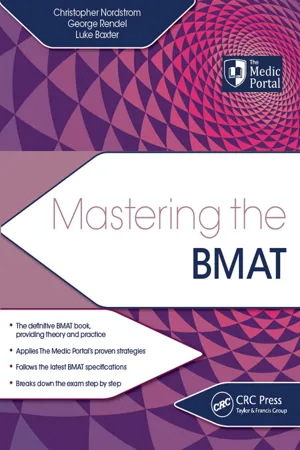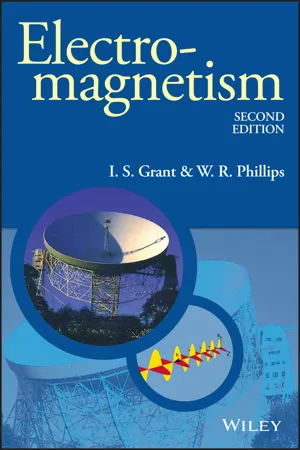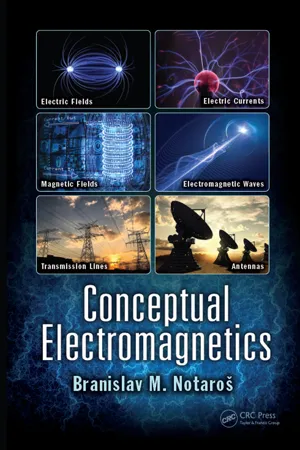Physics
Electrostatics
Electrostatics is the study of stationary electric charges and the forces they exert. It deals with phenomena such as electric fields, electric potential, and the behavior of conductors and insulators in the presence of electric charges. The principles of electrostatics are fundamental to understanding the behavior of electrically charged particles and the interactions between them.
Written by Perlego with AI-assistance
Related key terms
12 Key excerpts on "Electrostatics"
- Britannica Educational Publishing, Erik Gregersen(Authors)
- 2010(Publication Date)
- Britannica Educational Publishing(Publisher)
CHAPTER 2 ELECTRICITYT he phenomenon associated with stationary or moving electric charges is called electricity. Electric charge is a fundamental property of matter and is borne by elementary particles. In electricity the particle involved is the electron, which carries a charge designated, by convention, as negative. Thus, the various manifestations of electricity are the result of the accumulation or motion of numbers of electrons.Electrostatics
Electrostatics is the study of electromagnetic phenomena that occur when there are no moving charges—i.e., after a static equilibrium has been established. Charges reach their equilibrium positions rapidly because the electric force is extremely strong. The mathematical methods of Electrostatics make it possible to calculate the distributions of the electric field and of the electric potential from a known configuration of charges, conductors, and insulators. Conversely, given a set of conductors with known potentials, it is possible to calculate electric fields in regions between the conductors and to determine the charge distribution on the surface of the conductors. The electric energy of a set of charges at rest can be viewed from the standpoint of the work required to assemble the charges; alternatively, the energy also can be considered to reside in the electric field produced by this assembly of charges. Finally, energy can be stored in a capacitor. The energy required to charge such a device is stored in it as electrostatic energy of the electric field.ELECTRIC CHARGEElectric charge is a basic property of matter carried by some elementary particles. Electric charge, which can be positive or negative, occurs in discrete natural units and is neither created nor destroyed.Electric charges are of two general types, positive and negative. Two objects that have an excess of one type of charge exert a force of repulsion on each other when relatively close together. Two objects that have excess opposite charges, one positively charged and the other negatively charged, attract each other when relatively near.- eBook - ePub
Electromagnetism
Maxwell Equations, Wave Propagation and Emission
- Tamer Becherrawy(Author)
- 2013(Publication Date)
- Wiley-ISTE(Publisher)
Chapter 2Electrostatics in Vacuum
The interaction of electric charges, as expressed by Coulomb force, is formulated according to the Newtonian concept of action-at-a-distance: if a charge q′ is produced at r′ at a time t′, a charge q located at r feels the action of q′ instantaneously, whatever the distance |r − r′| and the medium that separates the charges. The concept of field was developed by Faraday, Maxwell, Lorentz, Einstein, and many others. In modern physics, all interactions are conceived as local, i.e. involving quantities defined at the same point r and at the same time t. Fields are physical entities that are endowed with energy, momentum, etc., and they may propagate with some finite speed as waves. Furthermore, in quantum theory, the same objects (electrons for instance) have both particle and wave properties.In this chapter, we introduce the concepts of electric field and potential, we derive the fundamental equations of Electrostatics in vacuum, and we discuss some of their properties and the concept of electrostatic energy.2.1. Electric forces and fieldIn a famous experiment, Coulomb used a torsion balance to measure the force of interaction of electric charges. He verified that a small charge q1 acts on a small charge q2 situated at a distance r with a force FE = Ko q1 q2 /r2 oriented along the line joining the charges. This force is repulsive between like charges and attractive between unlike charges. It has a similar mathematical form to Newton's law of universal gravitation To specify both the direction and the magnitude, we write[2.1 ]Coulomb's force obeys the principle of action and reaction. Ko is a constant that depends on the adopted unit of charge. Using the coulomb (C) as the unit of charge and the Heaviside or rationalized system, we write[2.2]εo is the permittivity of vacuum. The factor 4π is introduced to simplify the writing of equations. The electric force is much more intense than the gravitational force and the coulomb is an enormous charge on the human scale: electric sparks are produced by less than one microcoulomb and rubbing produces a charge of the order of the nanocoulomb per square centimeter - eBook - ePub
- Wai Kai Chen(Author)
- 2004(Publication Date)
- Academic Press(Publisher)
2Electrostatics
Rodolfo E. Diaz, Department of Electrical Engineering, Ira A. Fulton School of Engineering, Arizona State University, Tempe, Arizona, USA2.1. Introduction2.1.1. Conventions2.2. Sources and Fields2.2.1. D Fields of Charge Distributions Using Gauss’s Law2.2.2. First Alternative to Gauss’s Law: Integration over Charge Distributions 2.2.3. Second Alternative to Gauss’s Law: The Potential Function2.3. Boundary Conditions and Laplace’s Equation2.3.1. The Fields of Charged Conductors and the Method of Images 2.3.2. Laplace’s Equation and Boundary Value Problems2.3.3. The Connection Between D, P, E , and ε2.4. Capacitance2.4.1. Capacitance of Various Configurations and Energy 2.4.2. Partially Filled Capacitors 2.4.3. Static Current FieldsReferences2.1 Introduction
Electrostatics in its most restrictive sense is the specialization of Maxwell’s equations to a system whose sources are steady-state, time-invariant electric charges. Because the conservation of charge is implicit in this definition, the unifying principle of all the equations is the conservation of total electric flux. Therefore, Electrostatics also properly includes steady-state conduction current problems.In this chapter, the fundamental relationship between source and field is between the electric charge q (measured in coulombs) and the electric flux density D (measured in coulombs per meter squared) because that relationship has the form of a conservation law. The electric field E (measured in volts per meter) is introduced with the concept of the electrostatic potential Φ (measured in volts) as the quantity involved in the dynamics of electrostatic systems (i.e., their interaction forces and energies). In this way, ε (measured in farads per meter), the permittivity of the material medium through which the flux traverses, appears as a proportionality constant that gauges the amount of energy stored in a given electrostatic system. Capacitance C (measured in farads) is then a purely geometric expression of the arrangement of that energy inside the system. The concepts of Electrostatics are extended to the case of current flow in resistive environments by the recognition of the formal analogy between the electrostatic flux and the current density flux J (in amperes per meter2 - eBook - ePub
ESD Basics
From Semiconductor Manufacturing to Product Use
- Steven H. Voldman(Author)
- 2012(Publication Date)
- Wiley(Publisher)
Chapter 1 Fundamentals of Electrostatics1.1 Introduction
We are all familiar with electrostatic discharge (ESD): shuffle your feet across a shag carpet in your favorite sneakers, touch a piece of metal, and zap! For a human being, we let out an “ouch!”; but for micro-electronics to nano-electronics, this can lead to product failures [1].But, today, and in the future, static charge will remain an important industrial issue for the production of both electronic devices to systems. It is also an issue in fields of munitions, explosives, chemical, and material industries. Any industry where there is a risk of impact to quality, yield, degradation, or physical harm will be concerned with electrostatic discharge (ESD), electrical overstress (EOS), electromagnetic interference (EMI), and electromagnetic compatibility (EMC).In this book, a short survey of ESD from manufacturing to product use will be shown. The text will discuss fundamentals of Electrostatics, manufacturing electrostatic issues, component level issues, system level issues, to design.So, where did all this all begin?1.2 Electrostatics
The discovery of electrostatic attraction and electrostatic discharge is one of the world's earliest understandings of scientific thought and analysis. Its first discovery goes back to the early foundation of the problem of the nature of matter, astronomy, mathematics and foundation of Greek philosophy, and pre-dates the nature of matter.1.2.1 Thales of Miletus and Electrostatic Attraction
Thales of Miletus, born in 624 B.C.E and died in 546 B.C.E, was the founder of the Ionian School (or Milesian School) and one of the Seven Wise Men of Ancient Greece in the Pre-Socratic era. Thales was an astronomer, mathematician, and philosopher. He was an inventor and an engineer. Thales of Miletus established a heritage of searching for knowledge for knowledge sake, development of the scientific method, establishment of practical methods, and the conjecture approach to questions of natural phenomenon. The Milesian School is regarded as establishing the critical method of questioning, debate, explanation, justification and criticism. The students of Thales included Euclid, Pythagoras, and Eudemus [2]. - Lawrence N. Dworsky(Author)
- 2014(Publication Date)
- Wiley-IEEE Press(Publisher)
1 A Review of Basic ElectrostaticsElectric and magnetic phenomena, including electromagnetic wave propagation, are described by Maxwell’s equations.1 When nothing is changing with time, that is, when all derivatives with respect to time are zero, the electric and the magnetic phenomena decouple and become separate electric and magnetic phenomena. These are referred to respectively as Electrostatics, which describes the properties of systems with separated static regions of positive and negative electric charge (although the entire system is charge-neutral), and magnetostatics, which describes the properties of systems with electric currents and/or magnetized materials.In this book we shall consider only Electrostatics. This subset of a subset of topics describes a vast number of real-world situations. Chapter 2 describes some practical needs and uses of electrostatic analyses, the remainder of the book will be dedicated to examining several techniques for performing these analyses.The materials to follow are intended to be a quick review of the relationships that will be used throughout this book. The intent here is to provide a consistent set of notation using all the relationships that will be needed going forward. Many of these relationships are stated without derivation or proof. A more complete Electrostatics theory text is recommended for newcomers to the subject. There are very many excellent texts available. The references list at the end of this chapter is certainly not exhaustive, but the texts cited are considered standards in the field.1.1 Charge, Force, and the Electric Field
Electric charges exert forces on one another. This is the basis of Electrostatics. The characteristics of these forces are summarized in Coulomb’s law:- Electric charge carries a polarity, or sign. The choice of sign was originally arbitrary, but now is established by tradition—the electron, the most common charged subatomic particle, carries a negative charge.
- Nima Gharib, Javad Farrokhi Derakhshandeh, Peter Radziszewski(Authors)
- 2022(Publication Date)
- Elsevier(Publisher)
Chapter 3: Fundamentals of electrodynamics
Abstract
This chapter focuses on the fundamentals of Electrostatics for particles. Important ideas and terminologies are introduced for subsequent debate. In addition, we present essential equations and mathematical tools to emphasize the physical nature of the issues. The offered contents in this chapter will serve as a strong basis for investigations into related applications of Electrostatics of particles.Keywords
Charge Distribution; Electric Charge; Electromotive Force; Electrostatics of Particles; Farday's Law; Ohm's Law; Tribocharging1. Introduction to Electrostatics of particles
The introduction and fundamentals of electrodynamics theory were published by David Griffiths (2021) with a clear and accessible explanation for undergraduate and postgraduate levels in the Fourth Edition. It is good to emphasize that the textbook published by David has been designed with the conceptual difficulties frequently encountered by scholars and researchers, including students and senior researchers, which offer the theoretical phases with carefully selected examples and thorough illustrations. Therefore, the main relative sections of this chapter, which relate to the Electrostatics of particles, are chosen from the textbook of Introduction to Electrodynamics (Griffiths, 2021 ). The presented materials in this chapter will serve as a solid foundation for studies of related applications of Electrostatics of particles.For the majority of engineering applications, Newtonian mechanics is sufficient. However, when applied to objects moving at high velocities (close to the speed of light), it is incorrect and must be replaced by special relativity (introduced by Einstein in 1905); when applied to extremely small objects (close to the size of atoms), it fails for a variety of reasons and must be replaced by quantum mechanics (developed by Bohr, Schrödinger, Heisenberg, and many others). Because modern particle physics deals with extremely fast and extremely small objects, a mechanics that incorporates both relativity and quantum principles is required, which is known as quantum field theory; it was developed in the 1930 and 1940s but is still not considered a fully satisfactory system today. Therefore, considering some assumptions and simplifications, electrodynamic phenomenon can be considered by classical mechanics. Mechanics describes how a system will act under the influence of a specific force. There are just four fundamental forces that physics is now aware of, which are listed as follows in decreasing order of strength: (1) strong, (2) electromagnetic, (3) weak, and (4) gravitational. Categorizing forces according to the aforementioned list may generate the following questions: Where is the point of contention? Where is the “normal” force that prevents you from collapsing? Where are the chemical forces that connect molecules? Where does the impact force between two colliding billiard balls originate? The explanation is that they are all electromagnetic forces. Indeed, it is not hyperbolic to assert that we live in an electromagnetic world—nearly every force encountered in daily life, with the exception of gravity, is electromagnetic in origin. Because the strong forces that keep protons and neutrons together in the atomic nucleus have an incredibly narrow range, humans do not “feel” them, despite their hundredfold greater strength than electrical forces. Weak forces, which are responsible for some types of radioactive decay, are likewise short-ranged and significantly weaker than electromagnetic forces. Gravity, on the other hand, is so pitifully weak (in comparison to the others) that we only sense it in the presence of massive mass concentrations (such as the earth and the sun). The electrical attraction between two electrons is (10e42- eBook - ePub
Introduction to Electromagnetism
From Coulomb to Maxwell
- Martin J N Sibley(Author)
- 2021(Publication Date)
- CRC Press(Publisher)
2 Electrostatic FieldsMost of us are familiar with the phenomenon of electrostatic discharge: lightning strikes, sparks from nylon clothing and sparks from nylon carpet. It may be thought that the study of static electric fields has little to offer the electrical engineer. After all, we are taught that electrons flow in conducting materials, and so why should we concern ourselves with the study of static charges? However, as we shall see later in this chapter, Electrostatics introduces several ideas that will be very helpful when we consider capacitors and, ultimately, transmission lines.2.1 Coulomb’s Law
As we have seen in Chapter 1 , electronic charge comes in two forms: negative charge from an electron and positive charge from a proton. In both cases, a single isolated charge has a charge of 1.6 × 10−19 Coulomb. If there are two charges close to each other, they tend to repel each other if the charges are alike or attract each other if they are dissimilar. Thus, we can say that these charges exert a force on each other.Charles Augustin de Coulomb (1736–1806) determined by direct experimental observation that the force between two charges is proportional to the product of the two charges and inversely proportional to the square of the distance between them. In terms of the SI units, the force between two charges, a vector quantity, is given bywhereF =(2.1)rq 1q 24 π εr 2- F is the force between the charges (N)
- q 1 and q 2 are the magnitudes of the two charges (C) ε is a material constant (F m−1 )
- r is the distance between the charges (m)
- and r is a unit vector acting in the direction of the line joining the two charges – the radial unit vector
This is Coulomb’s law. The force, as given by Equation (2.1), is positive (i.e. repulsive) if the charges are alike, and negative (i.e. attractive) if the charges are dissimilar (see Figure 2.1 ). As Equation (2.1) shows, the force between the charges is inversely dependent on a material constant, ε - eBook - ePub
- Samarendra Kumar Biswas, Umesh Mathur, Swapan Kumar Hazra(Authors)
- 2021(Publication Date)
- CRC Press(Publisher)
The process of electrification (e.g., by rubbing glass with silk) is caused by the movement of electrons. In an uncharged body, atoms are electrically neutral, i.e., the total negative charge on the electrons is equal to the total positive charge on the atomic nuclei. Electrons are free to move, for example, during rubbing or when a body is placed in an electric field. An excess of electrons in a body, relative to its neutral state, means that the body is negatively charged. Similarly, a deficit of electrons relative to a neutral state means that the body is positively charged. The magnitude of the charge is expressed in coulombs (C).When the properties of flowing (current) electricity were discovered, the term static came into use to distinguish an electric charge that was at rest from one that was in motion. Today the term static electricity is used to describe phenomena from an electric charge, regardless of whether the charge is at rest or in motion.3 Streaming current or charging current (expressed in amperes) is defined as the flow rate of charge into a given system per unit of time. It is the current caused by the rate of flow of charged material into a system; it should be distinguished from the rate of static charge generation within a batch system, such as during the rubbing of solids or stirring of liquids.Static electricity involves high potentials, generally of the order of kilovolts, and very low currents, generally in the range of milliamperes (mA). Therefore, static electricity effects are associated with an electric field, but unlike current electricity, static electricity has no significant magnetic field effects.Earth is a near-infinite “reservoir” of electrons and is conventionally referred to as having zero potential. Therefore, if a charged conductor is electrically connected to the earth, its potential becomes zero. Earthing also removes all charge from a conductor unless there is another charged body in its vicinity that influences by induction.Bodies with unlike charges attract each other, and those with like charges repel. Based on Coulomb’s law, if two bodies (that are small compared to the distance between them), having charges Q 1 and Q 2 coulombs, are placed in vacuum at a distance of r (m) between them, then the force F - eBook - ePub
- Christopher Nordstrom, George Rendel, Luke Baxter(Authors)
- 2016(Publication Date)
- CRC Press(Publisher)
Physics 1. Electricity 1.1 ElectrostaticsA material may be an electrical conductor, in which case it will easily disperse any electrical charge that it gathers. Other materials may be electrical insulators that do not disperse charge easily.If an insulator is rubbed it may become positively charged by losing electrons, or it may become negatively charged by gaining electrons. Friction causes the displacement of electrons.For instance, an acetate rod that is rubbed with a duster will lose electrons to the duster and become positively charged. A polythene rod that is rubbed with a duster will acquire electrons and become negatively charged (the duster will be positively charged).Charged objects with the same charge will be repelled from each other. Objects with different charges will be attracted to each other.Static electricity is useful in some cases in industry, e.g. it can be used in spray painting. The object that needs to be painted is given a particular charge, and the paint droplets are given the opposite charge as they are released. This means the paint is attracted to the object and less is wasted.Static electricity also poses a danger in some cases. Build-ups of charge may eventually be dissipated in the form of a spark. In certain scenarios, such a spark may ignite a fire. Hence certain precautions need to be taken, for instance, with vehicles that are used to transport flammable substances. Any charge that is built up as the vehicle travels needs to be discharged using an earth wire – this reduces the chance of a spark igniting a fire.1.2 Electric currentCurrent (I) is the flow of charge (usually electrons, although currents can be carried by other charged particles such as ions) through an electrical conductor. Its unit is the ampere (A) - eBook - ePub
- I. S. Grant, W. R. Phillips(Authors)
- 2013(Publication Date)
- Wiley(Publisher)
CHAPTER 1
Force and energy in Electrostatics
The only laws of force which are known with great precision are the two laws describing the gravitational forces between different masses and the electrical forces between different charges. When two masses or two charges are stationary, then in either case the force between them is inversely proportional to the square of their separation. These inverse square laws were discovered long ago: Newton’s law of gravitation was proposed in 1665, and Coulomb’s law of Electrostatics in 1785. This chapter is concerned with the application of Coulomb’s law to systems containing any number of stationary charges. Before studying this topic in detail, it is worth pausing for a moment to consider the consequences of the law in the whole of physics.In order to make full use of our knowledge of a law of force, we must have a theory of mechanics, that is to say, a theory which describes the behaviour of an object under the action of a known force. Large objects which are moving at speeds small compared to the speed of light obey very closely the laws of classical Newtonian mechanics. For example, these laws and the gravitational force law together lead to accurate predictions of planetary motion. But classical mechanics does not apply at all to observations made on particles of atomic scale or on very fast-moving objects. Their behaviour can only be understood in terms of the ideas of quantum theory and of the special theory of relativity. These two theories have changed the framework of discussion in physics, and have made possible the spectacular advances of the twentieth century.It is remarkable that while mechanics has undergone drastic amendment, Coulomb’s law has stood unchanged. Although the behaviour of atoms does not fit the framework of the old mechanics, when the Coulomb force is used with the theories of relativity and quantum mechanics, atomic interactions are explained with great precision in every instance when an accurate comparison has been made between experiment and theory. In principle, atomic physics and solid state physics, and for that matter the whole of chemistry, can be derived from Coulomb’s law. It is not feasible to derive everything in this way, but it should be borne in mind that atoms make up the world around us, and that its rich variety and complexity are governed by electrical forces. - eBook - ePub
- Branislav M. Notaroš(Author)
- 2017(Publication Date)
- CRC Press(Publisher)
ELECTROSTATIC FIELD IN DIELECTRICS IntroductionDielectrics or insulators are nonconducting materials, having very little free charges inside them (theoretically, perfect dielectrics have no free charges). However, another type of charge, called bound or polarization charges, exist in a polarized dielectric, as atoms and molecules in the dielectric behave like microscopic electric dipoles. In electrostatic systems containing both conductors and dielectrics, the equivalent electric-field sources are both free and bound charges, considered to reside in free space. By introducing the concept of dielectric permittivity, we are left, in turn, to deal with free charges in the system only, while the contribution of bound charges to the field is properly added through the permittivity. In continuation, we analyze capacitors and transmission lines, composed of both conductors and dielectrics, to evaluate and discuss their capacitance, energy, and breakdown characteristics, as a culmination of our study of the theory and applications of the electrostatic field.2.1 Polarization of DielectricsEach atom or molecule in a dielectric is electrically neutral. For most dielectrics, centers of “gravity” of the positive and negative charges in an atom or molecule coincide – in the absence of the external electric field. When a dielectric is placed in an external field, of intensity E, however, the positive and negative charges shift in opposite directions against their mutual attraction, and produce a small electric dipole. The moment of this equivalent dipole is given by p = Qd, where Q is the positive charge of the atom or molecule (−Q is the negative charge), and d is the vector displacement of Q with respect to −Q. The charges are displaced from their equilibrium positions by forces [Eq. (1.3) ] Fe1 = QE and Fe2 = −QE, respectively. The displacement d is very small, on the order of the dimensions of atoms and molecules. The charges Q and −Q are bound in place by atomic and molecular forces and can only shift positions slightly in response to the external field. So, the two charges in an equivalent small dipole cannot separate one from the other and migrate across the material in opposite directions run by the electric field. Hence, these charges are called bound charges (in contrast to free charges). Some dielectrics, such as water, have molecules with a permanent displacement between the centers of the positive and negative charge, so that they act as small electric dipoles even with no applied electric field. According to Figure 2.1 , the torques (moments) of forces Fe1 and Fe2 with respect to the center of the dipole (point O) are T1 = r1 × Fe1 and T2 = r2 × Fe2 , with r1 and r2 denoting the position vectors of Q and −Q with respect to the dipole center. We notice that r1 − r2 = d - No longer available |Learn more
- Robert A. Pelcovits, Joshua Farkas(Authors)
- 2023(Publication Date)
- Barrons Educational Services(Publisher)
10Electrostatics
Learning Objectives
In this chapter, you will learn:Coulomb’s lawPrinciple of superpositionElectric fields and field linesElectric potential and voltageCalculating the potential due to a continuous charge distributionFinding the electric field given the potentialCalculating the electric field due to a continuous charge distributionWe begin our study of electric and magnetic phenomena by considering the interaction of stationary point electric charges. This is easy to do if we go back to Chapter 9 and replace the words gravitational force with electric force, and mass with charge. That’s right—the physics and math behind stationary point electric charges and universal gravitation are just about the same, with the exception that in gravitation there are no repulsive forces.Coulomb’s Law
The magnitude of the force between two point charges Q1 and Q2 separated by a distance R is given by the equationScalar part of Coulomb’s lawTIPNote the similarity with Newton’s law of universal gravitation, Chapter 9 .The direction of the force is along the line between the two charges. Like charges repel, while unlike charges attract.Coulomb’s law, like Newton’s law of universal gravitation, is an experimental result. However, it does make sense that the force increases with increasing charges and decreases with increasing distance between charges.ε0 is a constant called the permittivity of free space and is given ε0 = 8.85 × 10− 12 C2 /N · m2 . From your physics class, you may also be familiar with Coulomb’s law written in the form F = k|Q1 Q2 |/R2 , where k is called the electrostatic constant and has a value of k = 1/4πε0 = 8.99 × 109 N · m2 /C2 . ε0
Index pages curate the most relevant extracts from our library of academic textbooks. They’ve been created using an in-house natural language model (NLM), each adding context and meaning to key research topics.
